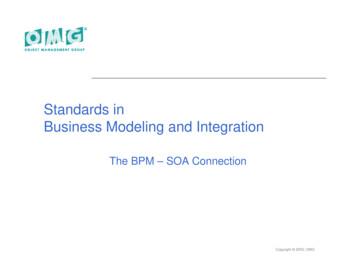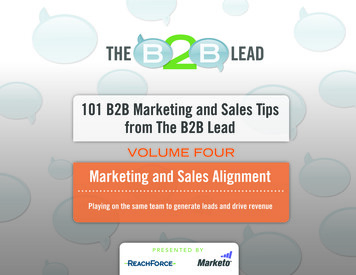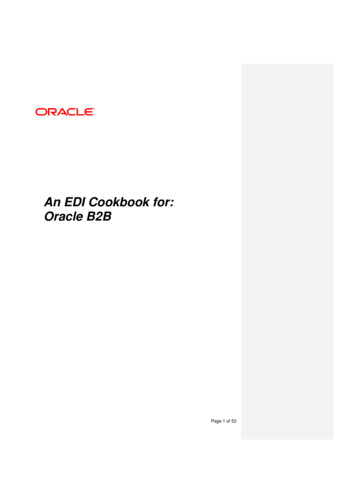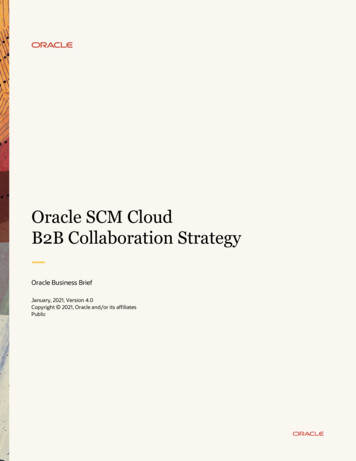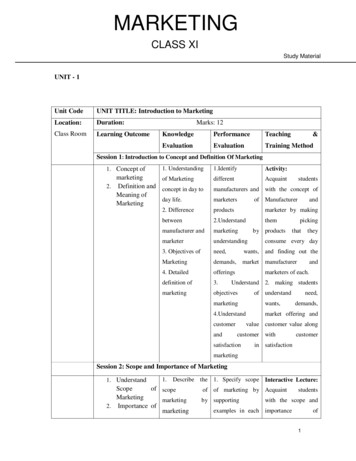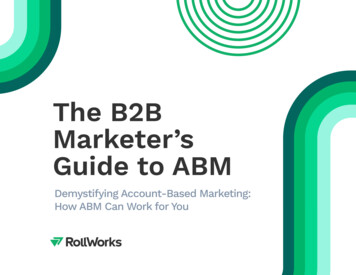
Transcription
The B2BMarketer’sGuide to ABMDemystifying Account-Based Marketing:How ABM Can Work for You
Account-based marketing (ABM) offers companies new ways to help marketing and sales teams work together,generating more valuable business, higher ROI, and more direct, personalized content to help you reach thecustomers most likely to add to your bottom line.Have you heard this selling point before but felt held back by traditional demand gen goals or expectations? You’renot alone. Many B2B marketers have been sold the concept that ABM is only for some chosen companies and takesa lot of effort to implement. We’re here to report that isn’t the case, and you can actually still leverage the channels,tactics, and investments already at your disposal. Unlike its sometimes-dated reputation, ABM isn’t a one-size-fitsall approach that forces demand gen marketers to forge an entirely new path. Plus, there really is no massive teamor massive budget required — just a more strategic mindset and a little reshuffling of “the old way of doing things.”It’s not a whole new way to market; it’s just a better way to market. And we’re here to let you in on a few key waysto take your current ABM mindset to the next level.The B2B Marketer’s Guide to ABM2
GETTING REAL: ABM VS. TRADITIONAL DEMAND GENERATIONTraditional marketing and sales in B2B organizations canbe cumbersome, resource-intensive, and fragmented. TheABM takes the guess-work outbest leads are often personally cultivated by individualof marketing, and instead allowssalespeople, while marketing often focuses on “spray andcompanies to leverage data andpray” approaches that can create waste and result in asmany poor leads as good ones. And in all but the smoothest-automation platforms to identifyrunning operations, the hand-off of leads and responsibilitiesthe best targets, figure out whofrom marketing to sales can be awkward and messy.the buyers are, engage them onABM is here to address most of these sometimes avoided,but very apparent issues. The biggest change in an ABMa mass scale with personalizedoutreach using a blend of channels,approach is a shift in focus from broad demographicand then smoothly transition thegroups or personas to target specific companies and buyingresulting high-quality accountcommittees. The goal is to build a unifiedmarketing and sales funnel for eachtarget account, weeding out just“anyone” and focusing on a databacked list that’s a far better bet thancontacts to sales while stillproviding marketing support. It’smarketing and selling with thesame goal: generating revenue.traditional lead-first demand gen.The B2B Marketer’s Guide to ABM3
Get Startedwith ABM
IDENTIFYING TARGETSAll marketing begins with identifying targets. For conventional consumer-facing marketing, these targetscan be pretty broad — “men aged 25-45 with a middle-class income and an owned home,” for example.For conventional B2B marketing, the targets are often narrower, focusing on personas including job roles,experience level, pain points, etc. That’s where traditional demand gen often falls short — it assumes that anyB2B buyer with that profile is worth investing against.Using historical data, many B2B marketers have come to realize that buckets full of “leads” rarely convertedinto truly revenue-generating customers and something had to stop. Instead, ABM starts at a more strategiclevel. It forces you to ask, what companies are the best fit for our products and services, turning them into thebest customers? That’s where investments show the greatest results.Instead of building an audience of similar people who might be interested in your products orservices out of a population of everyone on Earth, ABM isolates the accounts that are likely togive you business and the people who work in key roles at those companies.The first step, then, is to build out your hit list of companies, or Target Account List (TAL).And that begins by creating an ideal customer profile (ICP).The B2B Marketer’s Guide to ABM5
BUILDING YOUR IDEAL CUSTOMER PROFILEAn account-based ideal customer profile starts with descriptiveFor companies selling toconsumers, an ICP is a descriptiveprofile of the kind of personmost likely to buy your product.For companies looking tosupercharge growth with ABM,the ICP is almost the same thing,except that instead of lookingat individual people it looksat enterprises. So rather thanbuilding a persona for Jane Smith,the ABM approach would build apersona for Jane, Smith, & Assoc.characteristics: firmographics (what the enterprise looks like), andtechnographics (the technology stack used by the enterprise). It thenlayers on behavioral characteristics: how does the enterprise makedecisions, who do they engage with, and how do they engage withthem, and what is their intent for purchasing?This analysis can be quantitative, relying entirely on hard data, butthe reality is most companies might not have access to the level ofinformation required, and a fully quantitative approach might misssome specific nuance. Therefore, it’s usually best to supplement thenumbers with qualitative assessments that can provide additionaldetail and context to the numbers. It’s also important to dig throughinternal sales history to make sure that the ICP makes sense based onwho has given you business in the past.For a full dive into building an ICP, take a look at RollWorks’ guide for using an ICP in ABM, which includes a helpful templatefor putting together one of your own. And remember that you’re never really “finished” developing your ICP — it’s a processthat may need to be iterated over and refined regularly depending on changes within your business.The B2B Marketer’s Guide to ABM6
BUILDING YOUR TARGET ACCOUNT LIST (TAL)Once you’ve established an ICP, it’s time to buildWhen building your TAL, here are a fewyour target account list (TAL). A TAL is a strategictips and tricks to keep in mind:list of accounts most likely to buy your product/service, generated from an ideal customerprofile (ICP) that serves as the core go-to-market(GTM) strategy between marketing, sales, andcustomer success. Using a combination of staticand dynamic data to build and tier accounts,marketing and sales are able to prioritize whichaccounts to reach, with what budget, and when.While a TAL may sound complex, buildingone shouldn’t be. After all, you put effort intobuilding an ICP for a reason — that’s yourblueprint of attributes for pulling together a listof real companies that are a match.Generate your total potential TAL:Using available vendor data, place each possibletarget account into a list. You should chooseaccounts based on how well they fit your ICP.1Right-size your list:Determine the ideal number of accounts in yourTAL by analyzing your revenue goals, estimatedconversion rates, and seller headcount. If too large,consider further limiting your ICP profile or manuallyreducing accounts based on region or company size.2Get a TAL capacity calculator:These handy little tools set the baseline TAL sizeyou’ll need to accomplish your revenue goals.Using the RollWorks TAL capacity calculatortemplate, you can better understand typical dealsize and conversion rates, create multiple TALs ifneeded, and clarify seller quotas based on clearrevenue objectives.3The B2B Marketer’s Guide to ABM7
ACCOUNT SCORINGScoring is the backbone of a high-performing ABM plan, so it’s importantto know what you’re looking for. A good account score is made up ofthree components:Fit: How similar is the account to your ICP — this includes firmographics,technographics, and other “looks like” factors that have been good business foryou in the past (Tip: Machine learning models can help with this).Intent: What are the purchasing goals of the account? Are they inmarketing for your category or product? Are they buying today or tomorrow?A month from now?Engagement: Engagement is all about behavior — how is the accountinteracting with your brand across all channels throughout their buying journey?You can begin to tier your TAL early on by measuring intent signals, such as an account’sconsumption of specific content on B2B websites. Engagement signals, consisting ofdirect interactions with your company, are even more powerful interest indicators.The B2B Marketer’s Guide to ABM8
ACCOUNT TIERING/ROTATIONSo far, the only real difference we’ve talked about between ABM and traditional demand genmarketing is a smaller pool of target accounts, the TAL. Tiering and rotation, the next step, iswhere the magic of ABM combines with marketing automation to supercharge your funnel.Tiering is the process of breaking up your scored TAL into individual tiers based on how valuablethe account is and how resource-intensive reaching them will be. The more valuable the account,the higher their score, and the more comprehensive attention they’ll need, the higher the tier.Each tier should have its own marketing plan and workflow — the higher the tier, the moreinvolved. A good rule of thumb is to spend two to five times more resources on a tier thanthe tier below it. As you monitor engagement and intent, you can rotate accounts and movethem up or down the tier ladder. This allows you to focus your marketing budgets on the mostimportant accounts but also keeps your team from over-saturating any one account. As highertier accounts drop down, resources are freed up to address lower-tier ones.As you rotate through your accounts, you may find that some drop out of your TAL. That’s okay— your TAL can and should be updated regularly, with timing based on your sales cycle.The B2B Marketer’s Guide to ABM9
EngagingAccountsYou have your ICP and your TAL, and all the accounts are scored and ranked by tier.Now it’s time to start engaging them. Unlike traditional demand gen marketing, you’llbe building out engagement plans based on tier rather than a single one-size-fitsall solution. This lets you put resources where they’ll get the highest return, withoutlosing sight of lower-tier accounts.The B2B Marketer’s Guide to ABM10
ENGAGEMENT CHANNELSWith a fully fleshed out TAL, it’s time to open the playbook andThe good news is that the channelstailor strategies for each audience. If you’ve done your researchyou’ll be using for ABM are no differentright, you will be aware of the various pain points, opportunities,from the channels used in traditionaland signals that target companies need to move down the salesapproaches. These will includefunnel. You should also know how they like to be approached,what channels are most impactful when, and who in thoseEmail marketingorganizations needs to be looped in at each step.Digital adsAutomated sales outreachThis similarity is by design. ABM doesn’t replace traditionaldemand gen approaches — it just allows you to think of thoseE-gifting and direct mailchannels in a more nuanced and personal way, increasingPersonalized informationallanding pages and contentengagement and win rates as you go along. And a good ABMOn-site chat botsstrategy will use all of the channels available, since not everystakeholder at every account will necessarily be reachable inthe same way.Virtual (or hybrid) eventsContent syndication.and of course, many more!The B2B Marketer’s Guide to ABM11
SALES AND MARKETING ALIGNMENTOne of the strongest advantages ABM has overWhen engaging with your TAL, both marketinga traditional demand gen approach, especially inand sales must be aware of the following factors:enterprise organizations, is how closely it can tie thesales and marketing staff. Because ABM realignsmarketing toward an account focus, it immediatelymakes sense to the sales team because that’s theway they’ve always worked. And because of the tieredapproach, marketing produces content that helps salesmake connections at every step of the sales cycle.Where the account is in the buying journeyWhat messaging would be mosteffective for each accountIntent and engagement statistics foreach accountWhat channels have been engagedfor an accountSpecifics on the makeup and stakeholdersof an account’s buying committeeIf marketing has no idea what progress hasalready been made with an account, they are unable to craft content specific to them.If sales is unsure about messaging, an account can receive mixed messages.The B2B Marketer’s Guide to ABM12
INTERPRETING READY-TO-BUY SIGNALS FOR SUB-SEGMENTATIONWhile picking channels is key, you also need to be more aware of when to activate them and which segments togo after. That’s where ready-to-buy signals come in. They’ll dictate the cadence and effort you put toward certainaccounts, also known as sub-segmenting.Ready-to-buy signals shouldn’t be something new at this point (yes, you already rely on them when building targetaccount scores and prioritizing). All three attributes (fit, intent, and engagement) need to be taken into consideration asyou continue to engage across channels. A company showing high intent toward similar products and even engagingdirectly with your marketing can still be a poor fit due to company size, alone — and therefore not worth your time andresources. Along the same lines, a company with a perfect fit but showing no signs of intent can be a prime candidatefor future outreach.Keeping a pulse on ready-to-buy signals can seem tricky, but regularly evaluating your TAL andcomparing current account behavior to past account behavior can give you a good idea ofwhat to look for. You’ll be able to ingest different data signals to create sub-segmentedaudiences based on behavior, versus treating your entire TAL in a uniform manner. If youhave a sub-segment of accounts that are high-fit and high-intent, yet haven’t shown muchengagement, you’ll engage that audience differently than one that is high-fit showing nointent or engagement.The B2B Marketer’s Guide to ABM13
INTERPRETING READY-TO-BUY SIGNALS FOR SUB-SEGMENTATIONEven with accounts being tiered or segmented based on these three data signals, sometimes even morepersonalization is called for. That’s where further audience segmentation comes in. Creating subsegments allows your team to craft specific messages for specific circumstances and companies, whichis key to high-touch ABM tactics. For each sub-segment you identify, your engagement and outreachbecomes more personalized.These sub-segments can be funnel-stage based, for example changing the kinds of marketing accountsthat are near closing. Or they can be based on organizational level or role, for example sending differentmessaging to directors vs. managers or technical vs. non-technical recipients. Subsegments can also be used for testing marketing approaches. By creating a testsub-segment, you can experiment with new tactics and strategies without needingto roll out to your entire list.The B2B Marketer’s Guide to ABM14
REFILLING THE FUNNELAccounts drop out of the pipeline for all manner ofreasons. Some are won, others are lost, some pivot toThe important thing toan entirely new business model, and some go out ofremember is that your TALbusiness. To keep an ABM strategy going, you’ll need toneeds to be big enough to meetconstantly fill gaps in the pipeline.sales goals. Regularly revisitingthe TAL capacity calculator willlet you know how many newaccounts need to be added atFor companies moving to a strict ABM model, thatany given time, helping youmeans doing prospecting and researching, and thenensure the pipeline never driesmoving accounts manually into the pipe for scoring.A hybrid model, on the other hand, still maintains atraditional demand gen marketing approach at the verytop of the funnel and then moves the conventionalleads generated into the ABM pipeline. Both are greatup. In an ABM funnel, onlyaccounts on your TAL count, soit’s important to monitor andrefill the list regularly.approaches, and there is no one-size-fits-all answer.The B2B Marketer’s Guide to ABM15
Framing ABM PlaysOne of the most powerful advantages of an ABM approach is that it lets you breakyour marketing down to “plays”: simple, repeatable, templated strategies that canhelp you figure out what to do in any situation. A full playbook is beyond thescope of this document, but it’s useful to see an example from AdRoll.The B2B Marketer’s Guide to ABM16
THE 3X3X3 ABM PLAYThe goal of this play is to engage both knownand unknown accounts with three offers,through three channels, over a period ofthree weeks. The 3x3x3 ABM play is a solidtactic to build out your pipeline in less than amonth and can be an effective starting pointfor teams new to ABM.Informed by your audience segmentationdata, your offers should be spaced out overa solid timeline with clear objectives for eachweek. When it comes to the three channels,however, keep these goals in mind for each:Digital advertising:This channel will be your best bet to gather new audiencesand build out your account data for unknown accounts.Start with account-targeted ads with personalized dataabout the company, then move to contact targeting basedon the sales stage and serve ads directly to known contacts.Finally, retarget high-intent accounts on your TAL toincrease return visits and engagement.1Marketing automation emails:In the context of the 3x3x3 ABM play, marketing automationemails are a perfect supplement to the digital ads in the firstchannel. Send personalized emails from the sales memberwho has ownership over the account. Keep it simple —plain text emails come off as more genuine and bespoke.Consider adding a personalized asset like a message directlyfrom the assigned sales rep to increase click-through rate.2Sales follow-up:If an account responds meaningfully to the first twochannels in this play, coordinate with sales to follow updirectly. High-touch sales tactics like setting up directmeetings and mailing personal gifts are now in play.Whatever you do, make it personal.3The B2B Marketer’s Guide to ABM17
THE 3X3X3 ABM PLAYYou will likely need to mix up your channels and messaging at different stages of yourABM funnel. Informed but unengaged audiences can become fatigued if you continueto pursue them through the same channels. So mix it up, get personalized, and turnengaged accounts into closed sales.The B2B Marketer’s Guide to ABM18
Measure Reach and RevenueSo you’ve built your target accounts, and you’ve engaged them — now what? Let’sjust say, if you can’t measure it, you can’t fix it. That’s why ABM measurement can’tbe overlooked. The only way to know which channels and tactics are working foryour audience is to establish a flexible system of metrics to evaluate your progress.That means tracking from bottom-line GTM impact to account progression to moregranular channel-by-channel/program metrics. Each bucket of metrics providesdistinct insights that will enable you to optimize programs and strategies to get thebest results.We recommend breaking out your measurement into the following:The B2B Marketer’s Guide to ABM19
ULTIMATE ABM IMPACT METRICSThis is what you’re ultimately trying to prove over time: impact across theentire business through an account-based strategy. After all, it’s a unifiedapproach across GTM teams and should have a long-term impact on thecompany as a whole — leveling up your traditional demand gen lead metrics.These metrics, ranging from acquisition to retention and expansion, willlook something like these:ULTIMATE ACQUISITION ABM METRICSTAL Opportunities: The totalopportunities generated from TALTAL Close Rate: The rate at whichopen deals are converting to wonTAL Pipeline: The total pipelinegenerated from TALTAL Average Contract Value: Theaverage contract value of all dealsTAL Pipeline Value: The dollarvalue of the net new opportunitiesgenerated as defined aboveTAL Revenue: The total revenueearned on all accountsTAL Sales Velocity: The average speedat which an account moves throughthe pipeline to generate revenueTAL Average Recurring Revenue(ARR): The total revenue recurringfrom accountsThe B2B Marketer’s Guide to ABM20
ULTIMATE ABM IMPACT METRICSULTIMATE RETENTION ABM METRICSULTIMATE EXPANSION ABM METRICSCustomer Churn: The rate at whichcustomers stop doing business with youUpsell Opportunities: The totalopportunities generated for upsellRevenue Churn: The percentage of revenueyou’ve lost from existing customers in a givenperiod of timeCustomer TAL Upsell Contract Value: Theaverage contract value of all upsell dealsNet Promoter Score (NPS): A quantitativemeasure of general satisfaction and loyalty toyour brandRetention Rate: The ratio of customers thatreturn to do business at your companyCustomer TAL Upsell Win Rate: Thenumber of TAL upsell deals closedCustomer TAL Upsell Sales Cycle Length:The average length of time it takes to movean upsell deal through to closeCustomer Lifetime Value (CLV): A measureof how much revenue is generated by a singlecustomer over timeWhile this breadth of metrics can seem daunting, you won’t be seeing this impact overnight (that’s the point!). You canbuild these into your long-term reporting across GTM teams over time and rely on other leading indicators of successlike account progression and channel performance as your program reaches full maturity. It can take up to a full salescycle to see results above, so stick to the course and focus on optimizing programs in the meantime.The B2B Marketer’s Guide to ABM21
ACCOUNT PROGRESSION THROUGHOUT BUYER’S JOURNEYWhile you continue to build and iterate programs, trackingaccount progression throughout the entire buyer’s journey isThese metrics, typically evaluatedcritical not only for measuring success — but also for informingon a 30-60-90 time period, willareas of improvement. Unlike traditional demand gen that trackslook something like trackinghow leads move through a journey, ABM tracks an entire accountprogression vs. regression fromand its various buyers.these stages (you also should haveThis gives you a pulse check on where accounts may be progressinga post-sales funnel! But we cansmoothly or potentially get stuck. Too much open pipeline andget to that outside of our “gettingnot enough closing? That’s your signal to address this with newstarted” guide).channels or tactics. Typically, this looks like tracking progressionor regression through whatever custom stages you’ve defined,which can have various data sources (advertising, site traffic,CRM details, etc.). You may consider accounts unaware if they’vebeen off-site for over a month, or consider them aware if they’revisiting a specific page within a certain time frame. This changesas you move through lower funnel and post-sale stages, includingengagement and changes within an account.EXAMPLE PRE-SALE ACCOUNT PROGRESSIONUnawareEG. HAVEN’T VISITED THE WEBSITEAwareEG. VISITED WEBSITE IN LAST 90 DAYSEngagedEG. DOWNLOADED CONTENTOpen OppsEG. PROPOSALClosed WonEG. CONTRACT SIGNEDThe B2B Marketer’s Guide to ABM22
CHANNEL-BY-CHANNEL PERFORMANCEHere’s where traditional demand gen marketers might feel a little bit more comfortable:channel-by-channel performance. And that’s what’s great, because channels will neverbe something you don’t measure. They’re the needle you have to tweak to reap themajor ABM benefits over time. Without insight into what channels or programs areperforming best, you’ll be unable to control higher-level metrics that impact the wholebusiness. This is where investment decisions get made. You’re probably measuringmany channels at once, but here’s the classic breakdown of a few top channels:The B2B Marketer’s Guide to ABM23
CHANNEL-BY-CHANNEL PERFORMANCEEMAIL METRICSDIGITAL ADVERTISING METRICSWEBINAR METRICSTAL Targeted: Thenumber of accountson our target listfor the campaignTAL Targeted: The totalnumber of accounts targetedin a campaignTAL Registrants: The number ofTAL registrants for webinarTAL Open rate:The amount of TALto open emailTAL Click to openrate (CTOR): Thenumber of TALclicking CTA fromopenTAL Unsubscribes:The number of TALopting out of emailsTAL Reached: The totalnumber of accounts reachedin a campaignTAL CPM: The total cost perTAL impressionTAL Attendees: The number ofTAL registrants who attend webinarTAL On-demand viewers: Thenumber of TAL who view the ondemand recordingTAL CTR: The total TAL clickthru rateTAL Meetings generated: Thenumber of TAL meetings generatedfrom webinar campaignsTAL Conversion rate: Thetotal conversion (formfill, page visit, etc.) for thecampaignTAL Opps generated: The numberof webinar campaign members(registrants & attendees) from TALwho translate into oppsThe B2B Marketer’s Guide to ABM24
How Demand Gen MarketersCan Run ABM with RollWorksTaking the next step from traditional demand gen to ABM should now feel a little (no, a lot) less intimidating. Andthat’s especially true when you’re able to rely on products, processes, and people that have been doing ABM foryears. With the right data at your fingertips, taking your lower-impact demand gen programs and turning themup a notch is what RollWorks does best.By integrating with your pre-existing marketing and sales tech stack, RollWorks enables you to identify your besttargets, engage them across channels, and measure for impact and optimization throughout the entire accountjourney. And that’s true for marketing teams of 2-2,000 — yes, you heard that right. ABM is no longer a strategyonly left for big companies and massive budgets. ABM is exactly what demand gen marketers need to get evenmore impact and prove their value not only to themselves but to the entire company.The B2B Marketer’s Guide to ABM25
The Next StepNow that you know what ABM can do for your company, start your ABM journeyby scheduling a deeper dive with RollWorks. Additional resources on each of thetopics in this guide also elaborate on commonly asked questions.But why wait? Get in touch with RollWorks today and start using ABM to get yourmessage in front of the highest-value buyers in your industry.
RollWorks, a division of NextRoll, Inc., offers ambitious B2B companies an account-based platformto align their marketing and sales teams and confidently grow revenue. Powered by proprietary dataand machine learning, RollWorks’ solutions address the needs of organizations large and small —fromthose with best-in-class ABM programs to those just beginning their exploration. By empoweringteams to identify their target accounts and key buyers, reach those accounts across multiple channels,and measure program effectiveness in their system-of-record, RollWorks is an indispensable platformfor marketers and sellers who believe that an account-based approach is just good business.To learn more visit www.rollworks.com
Marketer's Guide to ABM Demystifying Account-Based Marketing: . Email marketing Digital ads Automated sales outreach E-gifting and direct mail . a traditional demand gen approach, especially in enterprise organizations, is how closely it can tie the sales and marketing staff. Because ABM realigns marketing toward an account focus, it .



